For Wisdom: this is an experiential piece I penned on what I refer to as the phenomenon of “contemplative homelessness.” As a longtime social justice advocate, I remain highly cognizant that it may arouse resistances in some readers, which it is incumbent upon me to accept. While some of you might see this as an exercise in the appropriation of economic-cultural labeling where no such labeling is warranted, I assure you: this essay is more nuanced than it first appears.
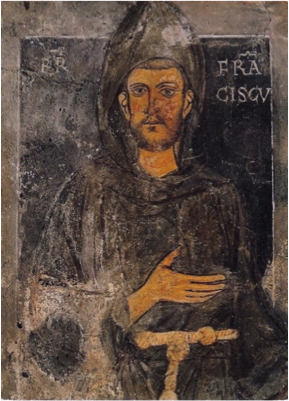
My former employment with non-profit organizations catering to chronically marginalized peoples has incrementally opened windows for me to radically empathize with the struggles and very profound gifts accessible in this gorgeously diverse population. Therefore, I remain aware of the arguments against serving as an “intermediary-voice” between the narrative issues of the homeless and what I must convey. I must also acknowledge the lack of sustained dialogue engaged between myself and persons inhabiting this on-the-spot location in one of our biggest cities.
And yet, I am of the “good-natured news” that exploring the undesirable shadows of our existence does in fact align with a contemplative ethos. Exploring contemplative patterns of light is fine and well. Oh, how I love the numinous! Getting to the practical, nitty-gritty details in the contemplative experience is what the inner work allows us to not only practice, but also to discuss. Otherwise, without knowing the shadows of who we are, we become the we cast onto the world.
If we are not housed as we would like, then let us become homed in the integral awareness of God. May we descend into the shadows of our being, where the home of the heart awaits our self-reconciling union.
All love in the homeness of the All,
Joshua Tysinger
 Crumbling urban asphalt crackles below the greasy mist of a Crisco-thick haze. I think about trekking down Alameda St. The sickening residue of waste poured out and streaming alongside street side gutters stifles my good vibrations. Even a breezy Brian Wilson song cannot save the broiling inanimate homeless bodies strewn about the urban jungle’s concrete. Think the ever-succinct lyrics to Sloop John B., “Let me go home… this is the worst trip I’ve ever been on” and then you have my condition. More accurately, you have the condition of the homeless. I want wind to blow. Desperately. Of course, it is all very stagnant.
Crumbling urban asphalt crackles below the greasy mist of a Crisco-thick haze. I think about trekking down Alameda St. The sickening residue of waste poured out and streaming alongside street side gutters stifles my good vibrations. Even a breezy Brian Wilson song cannot save the broiling inanimate homeless bodies strewn about the urban jungle’s concrete. Think the ever-succinct lyrics to Sloop John B., “Let me go home… this is the worst trip I’ve ever been on” and then you have my condition. More accurately, you have the condition of the homeless. I want wind to blow. Desperately. Of course, it is all very stagnant.
The sun’s ambivalence in projecting its beaming, luminous gaze onto the sweltering sidewalk is duly noted. It wouldn’t want to look down even if it could. As the heat rises, so does the stench of decomposing food and bodily discharge perfume the block. How could it not? Its bombastic radiance abounds like a midnight solar-disc and yet, sadly, the sun never shows itself to its crowd of sleepy onlookers. Only dust particulates free-float in the ether as crack-like mists consecrate the lightbulb breeze. This strange plunge into the heartless void of all humanity must have been predicted by Brian Wilson in a fit of visionary somber. The factuality of Wilson’s topical Pet Sounds soundtrack to my inner-movie while strolling up this embarrassing landscape remains infallible. It is indeed the worst trip I’ve ever been on.
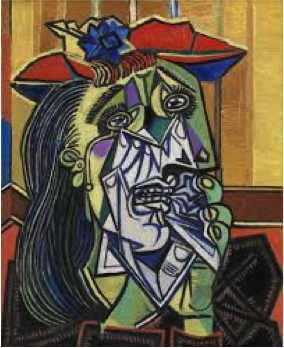
Said noontime delirium jostles my disembodied senses into incommunicable fragments of existential dread. The gnarly pang in my stomach is not now overwhelming. It does, however, gradually metastasize with the suburbia-infused smog that hangs low upon N. Los Angeles St. This is not the kind of air that you’d want to send home to mom. As I tediously lumber forward from Union Station to the Last Book Store on S. Spring St., gasping for breath and a less bitter taste, it suddenly hits me: I-am here. No, rather, it has found me. It has caught-up with who I am. But what is the mysterious It? I have officially landed in the desolate, roaring epicenter of a disintegrating Los Angeles.
In an attempt to nurse my stomach back to a semblance of stability, I hunker down in the middle of this apocalyptic urban battlefield. Just a few blocks from Union Station, a lush, grassy knoll emerges where at least a dozen or more homeless mill about. They aimlessly bob in tandem to some scorched earth rhythm. The subterranean beat of radical suffering is nevertheless palpable. Their emaciated bodies compulsively pace back and forth upon the lawn’s lamenting while incoherent ramblings circuitously chastise ambiguous moving bystanders. Fragrant cloud plumes igniting from half burnt cigarettes lounge loftily between encampments and hazed out sky. The remainder of the non-active homeless remain concealed from the sun. Moldy blankets or dilapidated tents are available if they are fortunate enough. Through the smog, I begin to see clearly.
Halfway up to the Los Angeles Mall, I step aside to assess the moderate sized lumps protruding from mangy sleeping bags scattered across the park. The good angelic officials of the city of Los Angeles abandoned them long ago. While millions of dollars have been invested in research-based programs and studies citing the causations of city homelessness, a whopping 16% increase in the Los Angeles street-person population has spiked over the past year. Skid Row is everywhere. Especially in the sprawl. It is a bottom-up phenomenon trickling into the suburbs. Consider the California cost of living. I wonder: has this town given up on itself?
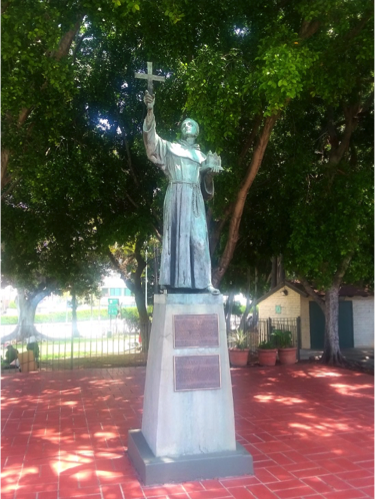 Rounding the bend toward the top of a hill, the outstretched arms of a statue of St. Junipero Serra occupies a cool space in the shade. This 18th century Franciscan is not an individual I’d desire to be erect on my lawn. Not here, not now. St. Junipero was, after all, a Spanish friar known for his brutal conversion and assimilation of indigenous peoples. Most frequently, his hospitality to the indigenous was doled out through punitive exploitation. Colonization and homelessness, now just as then, seem to make the world go ‘round. The dominant and the damned remain interwoven in the total depravity of a power-domination system thriving off of economic disparity.
Rounding the bend toward the top of a hill, the outstretched arms of a statue of St. Junipero Serra occupies a cool space in the shade. This 18th century Franciscan is not an individual I’d desire to be erect on my lawn. Not here, not now. St. Junipero was, after all, a Spanish friar known for his brutal conversion and assimilation of indigenous peoples. Most frequently, his hospitality to the indigenous was doled out through punitive exploitation. Colonization and homelessness, now just as then, seem to make the world go ‘round. The dominant and the damned remain interwoven in the total depravity of a power-domination system thriving off of economic disparity.
His meaningless castigation of the subordinated radiates from St. Junipero’s eyes down to the stony floor of his domain. In this very instant, the gravity of his looming presence strikingly coheres with the here-and-now smog lifting winsomely off the lawn. Oh! How it spirals around like gun smoke from where L.A. clean-up squads still roam like banshees. St. Junipero might still be found among them. Dissonant echoes of lingering desperation careen wildly across the emptiness of the park. Self-authenticated badges flicker upon shining batons of pointed flashlights that peer into homeless encampments by the devil’s stroke at midnight. The police must remain appalled by what has become of their own – or at least the upstanding civil servants among them.
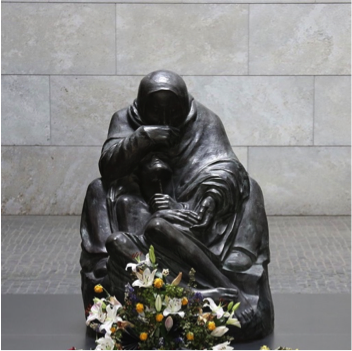
Spiraling in and out on this tearful trail, a Latino immigrant crouches next to his unconscious wife just a few yards away from where St. Junipero lingers in elevated repose with upwardly-hoisted cross. Her lethargy-addled body lays beneath blankets under a pitched cloth tarp. Mother Earth. He attempts to deliver the smallest amount of water to her parched, cracked lips, but to no avail. She must be sick. A fountain of tears well-up in his eyes. This is not the once upon a time life-vision he had dreamed of for his beloved when they migrated to California. To La La Land. A mirage-town fast asleep in its own lavish funhouse full of mirrors. Every damned oddity fits snug under the crass shade of his upwardly mobile cross as St. Junipero vacantly peers on.
Across the street, seven thickly quilted tents are strewn up in a logical format beneath an industrial metal canopy. Homelessness is an ornamental garb worn by the Los Angeles elite. I peer down at my own thrift shop clothing. 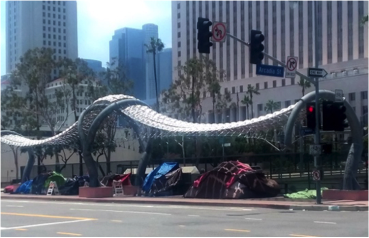 Like a good tourist, I snap a bevy of pictures of this makeshift street-palace that might any day leave. The urge to bring a take-home box full of photos is wholly irresistible. Phalanx upon phalanx of arid heat waves assault my eyes from the searing intermediate asphalt strip. I delude myself into thinking that I capture each blistering moment on camera. My phone has now been converted into a major bearer of homelessness tourism. Shot after shot of parched encampment dwellers teem with the hungry needs of a wandering ghost. Permanence and impermanence intermingle here, together. The image of a failing cultural climate on fire with its casual indifference towards its ever-warming tent dwellers surely never fades.
Like a good tourist, I snap a bevy of pictures of this makeshift street-palace that might any day leave. The urge to bring a take-home box full of photos is wholly irresistible. Phalanx upon phalanx of arid heat waves assault my eyes from the searing intermediate asphalt strip. I delude myself into thinking that I capture each blistering moment on camera. My phone has now been converted into a major bearer of homelessness tourism. Shot after shot of parched encampment dwellers teem with the hungry needs of a wandering ghost. Permanence and impermanence intermingle here, together. The image of a failing cultural climate on fire with its casual indifference towards its ever-warming tent dwellers surely never fades.
On the far side of the street, I walk briskly into an overcrowded circle of marginalized street men. The scene is located in the belly of an underused corporate building. This unofficial zone of homelessness activity offers many environmentally tortured homeless denizens the opportunity to seek their noonday shade. Some shave, while others brush their teeth. A self-organizing system of homelessness culture emerges into the periphery of my vision. As I unknowingly mosey through their lair, a battery of eyes pierces my gaze. I stop dead in my tracks before instinctively mobilizing my footsteps away from this unexpected bedlam of interrupted business. I know for a fact that I am not welcome in their presence. Their nonverbal behavior radiates this message to me quickly as I hook back up and to the right of the dimly-lit corporate shadows.
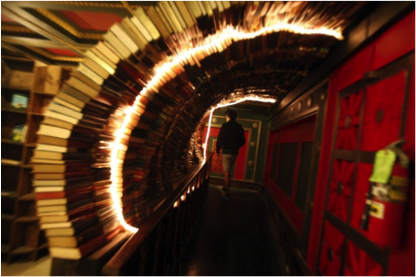 After all is said and done, I finally make my way to the Last Book Store. By the time I arrive, however, it is too late. Multiple waking hours of walking through this vehemently trashed dystopia and my nausea wins out. Game over. I stumble around the used bookstore museum for a few minutes of what feels like an eternity before falling out the exit. My stomach is a tortured, knotted prison of existential strife bubbling over with the smog of what I’ve known. It is undoubtedly time for me to concede my journey to the abysmal Heart of Darkness and venture back to the tenuous oasis of a suburban daydream. My twin brother, for who I am visiting from Raleigh, NC will surely be happy to see me.
After all is said and done, I finally make my way to the Last Book Store. By the time I arrive, however, it is too late. Multiple waking hours of walking through this vehemently trashed dystopia and my nausea wins out. Game over. I stumble around the used bookstore museum for a few minutes of what feels like an eternity before falling out the exit. My stomach is a tortured, knotted prison of existential strife bubbling over with the smog of what I’ve known. It is undoubtedly time for me to concede my journey to the abysmal Heart of Darkness and venture back to the tenuous oasis of a suburban daydream. My twin brother, for who I am visiting from Raleigh, NC will surely be happy to see me.
As the train departs from Union Station back to Santa Clarita, my heart pangs: oh, how I wish I could have joined them! How ironic. After all, I figure that they are “me.” To be more precise, who are “them” or “they” but otherized versions of what I see? We have merely been exposed to different life-algorithms auto-differentiating Who is who and between what we (currently) are. My reality is just a montage of dissonant interpretive events spliced into a singular working-frame of selected meaning. What I see is what I-am. Separation from homelessness, then: how arbitrary? As a contemplative follower of Christ, I-am that of which I see. I am in the profoundest sense of this inward montage, a bearer of homelessness too.
Home. The meaning has always eluded me. Look it up in Merriam Webster’s dictionary. It is the physical or perceived space where one exists permanently, either being a part of a family or household. Contrary to popular opinion, home is not a given. The enticing potential our private utopia with its imaginary reward-promises dangling in front of us is a future possible-security. Home, for many, remains illusory. The implication of having a home is the total wish-fulfillment of never-wanting in absolute safety. And yet for many, home is a representational pipedream that appears cruelly unobtainable. Reconsidering the idea of the permanence of homeness in the transitory reality of our world may then help to subvert conventional notions of what it means to be homeless.
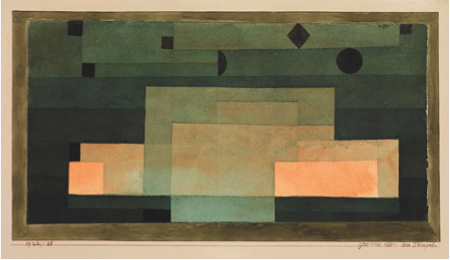
If we identify a house in comparison to a home, then what we really refer to is an objective physical structure. Physical-structures, just like bodies, are capable of hosting an inhabitant (or series of inhabitants!) for a time before completely dwindling away. A physical body is, after all, able to house the impenetrable area of self-transcendence that is untouched by fleeting worldly phenomena, known as the soul. A home such as the soul, perhaps, is this indefinable space of subjective-wholeness that self-organizes its reality. Its acausal nature allows it to remain mutually interdependent upon other self-organizing systems in the dynamic weaving-together of temporal realities, while also retaining its independence from them.
We might even say that home is the interior motivating-intelligence of the outer housing structure permeating beyond it in manifesting the world. Through intimate self-disclosure of its private inward condition, home whole-makes its environment, just as housing enables the home to be as it is. Building a home is the development of a soul; building a house is the development of a body. Both the infinite and the finite, the permanent and impermanent, the absolute and the relative, discover their necessity in the home of a realized-being.
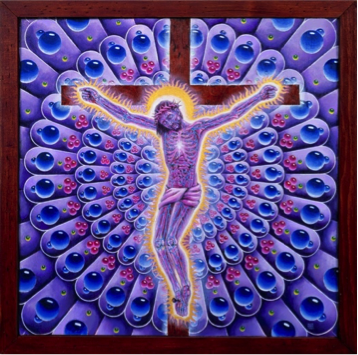
From my perspective, home means a lived-in perception of ultra-inhabited wholeness where all participants enjoy pervasive membership in an unbreakable relational-network of mutually indwelling sameness. Home is where one finds ultimate belonging and a never ceasing unity-in-difference with all persons in the absence of division. While our phenomenal identities and their subsequent distinctive characteristics represent a housing quality of being, true home is the indisputable wholeness potential that becomes activated by recognitions of love. We might appear to be different, possess alternate opinions, have endured variable experiences, both you and me. At the heart of our housing in Home, however, we are invariably identical! Love is the perfect adhesive in One-ness, making us so together in-Christ.
Perhaps home is the true reversal of traumatic separation. To be homed is to be consistent in-love with the Love that sets our relational bodies in motion. What we see “out there” is our own truest selves taking-shape in each moment – beautifully wrapped-up in the splendor of never knowing difference, while acknowledging other respective realities in their perpetual thou-ness. What we see, for better or for worse, is the inextricable product of integrated awareness. Because we are loved into being, we are homed as permanent residents. Permanent homeness is the integrated realization of a Love that undergirds all existence. One can never be separated from It, because in fact, Love is the only thing there is! The trauma of separation ceases to exist when we discover that we are homed, perfectly, by the Source of all that Is and that this has been true all along: without condition.
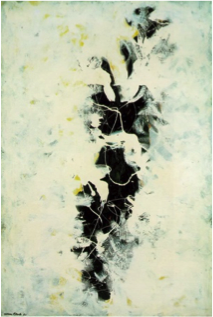
Although I cannot pretend to understand what the conventional “homelessness” social category means outside of its ontological meaning for me, I do know that many homeless persons fight to rename their condition. In fact, altering the name “homeless” to “houseless” intelligently rebels against any notion that they are not creators of their home. This conceptual radical-reversal brings up the legitimate proposition that even “housed” persons lack the luxury of a home – one that is existentially-stable and whole within its conditions. What our culture markets to us as “home” is truly a shell of an outward physical structure. The truth requires deeper penetration into the Source of all relationality for the actualization of wholeness. In this deeper penetration to the root of relational unity, can we then and only then convert our house into a dwelling.
When I say that I-am a bearer of “homelessness” in a culture as homeless as ours, I must tell you: it means that I-am home. To say that I-am a bearer of “homelessness” is an act of rebellion against the systemic oppression of a world that, frankly, does not care whether I am housed or not. I-am ultra-human: both a bearer of “homelessness” and at home in the revelation of my predicate homeness. If I lacked a house, I’m sure that I could do without. My sense of home is that big!
How I describe myself is less important than how I embody Christ – who was and still calls us to follow the perceived homelessness in Home of Its universal presence. It is this actual “kingdom of heaven” home that needs not a house, that calls us to deny our relative cultural-identities for the absolute treasures of the Spirit. Our self-created personal constructions love ephemeral luxury at the expense of permanent homeness. To be wanted, to uphold our reputations too, to accrue more and more wealth and material satisfaction: this is the desire of cultural-identity. To allow our cultural-identities to determine the value of our relational comparisons (i.e. us/them) is indeed, sin.
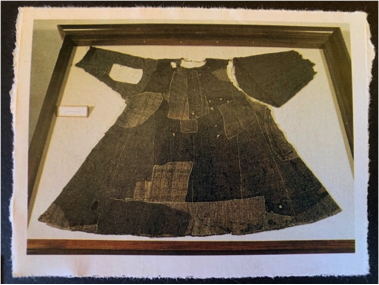
We must become culturally homeless while building a home in the Source of all Mercy. Being anchored in that Source manifests a viable inner poverty. The abstract notion of an inner poverty as a form of cultural homelessness may at first seem antiquated and/or an over-romanticized ideal that wrongfully misappropriates cultural-economic labels. Please allow me to further explicate, however, its subtle benefits in transforming our existential condition. When we act from a dynamic starting point of inner poverty (otherwise known as objectless-awareness) we thoroughly embody the objectless-activity of prayer without ceasing! As a result, our worldly behaviors become bound up in a radical wholeness. We become more spontaneous and ultimately more fluid in the way we self-communicate our source-ness to others. The art of conscious self-giving is an art that can be mastered! It can become a potent, empowering relational tool for the actualization of our being. Such a selfless mode of personal acting and perceiving results in an underlying subject/subject relationship with all elements of reality. In its most purified expression, our inner poverty does not know an “us” or a “them.”
In effect, the Source of Mercy becomes symbiotically unified with our personhood as the source of each exchange. As a non-transactional reward for conscious self-giving, then, what humble compassion we have to offer our environment fills within us a radiantly infused serenity. Paradoxically, when we give the totality of our being to others, we receive a heightened sense of wholeness in return! If such a subject/subject formula reveals exactly how God works, its effects remain no secret! Spontaneous acts of kindness do in fact become transformative gestures of self-charity. Gradually, our world flips upside-down from modes of functional receiving to becoming, in and of ourselves, a source of all mercy! We do not rely on desirable responses from others to initiate self-giving. Rather, as conscious cultivators of an inner poverty, we incarnate the self-creating first cause and Source of all Mercy that loves our neighbors into being.
If we are to evoke tangible change in our surroundings, we must become liberated, free-Spirited people that remain untouched by the self-insulation and empty promises of a fleeting material existence. We must also remain vigilant toward the possible vanity of bystander indifference. It is, after all, imperative to become allied with those whom our culture rejects. Only when we are “contemplatively-homeless,” together, can we begin to fathom what it means to make a home out of this one world that houses us. May we all, without exception, find this home in relation to one another.
posted September 17, 2019 by Joshua Tysinger
 Joshua Tysinger is a grateful long-time student of Rev. Cynthia’s Bourgeault. He underwent a radically transformative process of deepening consciousness that began in 2011 while working with the homeless in Asheville, NC. After a two-year discernment with mentors in the Episcopal Church, Joshua voluntarily enrolled at Wake Forest School of Divinity for continuing education. Although at the time still uncertain of his vocational direction, Rev. Bourgeault’s synchronous introduction of Joshua to renowned mathematician and philosopher Dr. Beatrice Bruteau in Winston Salem, NC ignited a fire in him for embodied contemplative teaching.
Joshua Tysinger is a grateful long-time student of Rev. Cynthia’s Bourgeault. He underwent a radically transformative process of deepening consciousness that began in 2011 while working with the homeless in Asheville, NC. After a two-year discernment with mentors in the Episcopal Church, Joshua voluntarily enrolled at Wake Forest School of Divinity for continuing education. Although at the time still uncertain of his vocational direction, Rev. Bourgeault’s synchronous introduction of Joshua to renowned mathematician and philosopher Dr. Beatrice Bruteau in Winston Salem, NC ignited a fire in him for embodied contemplative teaching.
The beneficiary of a year-long lineage transmission with Bruteau, Joshua later discovered (after Bruteau’s death) that he inherited the sum of her unpublished works. The vital content of her life’s literary legacy to this world was transferred to Emory University’s Pitts Library for safekeeping. Continuing guidance under Rev. Bourgeault, Joshua recently humbly accepted an invitation to “upgrade” the formal learning instruction of his transmission, more fully actualizing his contributions to Wisdom as Bruteau’s lineage-bearer. Joshua is now happily situated in Raleigh, NC, where he plans on crystallizing this blessing-imperative into formal spiritual teaching.
All Los Angeles photo images courtesy of Josh Tysinger; Saint Francis cloak photo courtesy of Laura Ruth

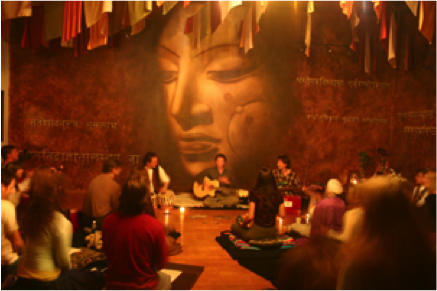
Josh, thanks so much for sharing this wisdom, which I personally find so resonant. The ‘feeling’ of homelessness and the sense of the home-ness as the source of that ‘feeling’ has been with me for quite a while. Your experiential piece for me has made the question even bigger and more whole. Specifically with how it relates to the “source of all Mercy.” As you say, “The trauma of separation (in whatever form that takes – mine) ceases to exist when we discover that we are homed, perfectly by the Source of all that Is and that this has been true all along: without condition” And what a profound commentary on two pieces of Luke – the Beatitudes and Home(less)Ness LK 6:20 “Blessed are you who are poor, for yours is the kingdom of God” and LK 9: 58 – “Foxes have holes and birds have nests, but the Son of Man has no place to rest.” The sense that our shared inner sense of poverty (restlessness) IS the spontaneous activation of the Source of Mercy is real and urgent! Namaste!